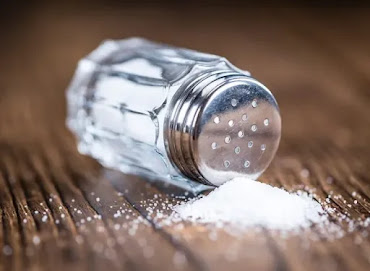Adding salt to food at the table linked to higher risk of premature death
Adding salt to food at the table linked to higher risk of premature death
- Studies have connected a high admission of table salt with expanded mortality risk, however ongoing information has been incongruous.
- Another review proposes that a higher recurrence of adding salt to prepared dinners was related with an expanded endanger of unexpected passing and lower future.
- Higher admission of leafy foods constricted or debilitated this relationship between salt use and expanded mortality risk
- Adding salt to feasts at the table records for 6-20% of everyday sodium admission, and restricting the utilization of salt at the table might actually have medical advantages.
A new report distributed in theEuropean Heart Journal shows that people who generally add salt to prepared feasts were at a 28% higher gamble of unexpected passing than the individuals who seldom add salt. A higher recurrence of adding salt at the table was likewise connected with a lower future.
Dr. Lu Qi, a disease transmission specialist at Tulane University and the review's important examiner, said, "This is the main review showing adding salt to dinners is connected with a higher endanger of sudden passing and more limited future. Adding salt is a way of behaving that could be changed; hence, our discoveries propose conduct alteration by decrease of adding salt to food varieties might be helpful to human wellbeing."
Surveying sodium admission
A few investigations have shown that a higher dietary admission of saltTrusted Source or sodium chloride is related with raised circulatory strain and an expanded gamble of cardiovascular sickness. Besides, studies have proposed a direct connection between salt utilization and all-cause mortalityTrusted Source.
Notwithstanding, different examinations have yielded clashing dataTrusted Source about the relationship between salt admission and mortality. For example, a portion of these examinations in unambiguous age bunches recommend that both low and high sodium admission are related with an expanded gamble of mortality.
A significant reasonTrusted Source for these clashing information is the trouble in precisely evaluating sodium consumption. A typical strategy includes assessing everyday sodium consumption in view of sodium discharge more than 24 hours utilizing pee tests. In any case, there is significant variety in sodium consumption from one day to another and such gauges over a solitary 24-hour time frame are probably going to be wrong.
Different specialists have utilized dietary studies or food records to gauge everyday sodium consumption. These techniques are inclined to blunder because of the difficulties related with precisely estimating the measures of food varieties devoured or the disappointment of the review's members to report the utilization of fixings or table salt.
In addition, assessing sodium admission because of the utilization of handled food varieties utilizing dietary overviews can be testing a result of the variety in sodium levels in similar food item from various brands. Handled, prepackaged, and café arranged food varieties represent around 70% of everyday sodium intakeTrusted Source, featuring the significance of precisely surveying sodium levels in these food things.
One more disadvantage of utilizing dietary studies is that they might neglect the impacts of potassium consumption. Numerous food sources that contain high sodium levels additionally contain elevated degrees of potassium. Higher potassium levels are gainful for wellbeing and could diminish the antagonistic effects of high sodium admission on wellbeing. Since table salt is chiefly made out of sodium chloride (97-close to 100%), evaluating the recurrence of adding salt to food can give a proportion of sodium consumption free of potassium admission.
Because of these challenges in measuring the degrees of sodium consumption, the current review evaluated the connection between how much of the time people added salt to their food and mortality risk. The specialists in the ongoing review noticed that past examinations have shown that the recurrence of adding salt to food can demonstrate a person's drawn out inclination for salt. Also, such salt utilization ways of behaving are less vulnerable to everyday varieties in salt admission.
Urinary sodium levels
The current review comprised of information from the greater part 1,000,000 people with a typical age of 57 years of age who had elected to impart their wellbeing information to the United Kingdom Biobank data set. The specialists utilized a survey to decide how frequently the members added salt to prepared feasts.
In light of their reaction, the members were classified as never/once in a long while, at times, for the most part, or continuously utilizing salt at the table. The analysts likewise acquired pee tests from the members to survey urinary sodium and potassium levels at gauge.
The scientists tracked down a positive relationship between's the recurrence of adding salt and urinary sodium focus. Conversely, a higher recurrence of adding salt related with lower urinary potassium levels.
The recurrence of adding salt to food sources was additionally connected with the degrees of sodium discharged more than 24 hours, assessed in view of the urinary sodium levels estimated utilizing the pee test.
The relationship between the recurrence of adding salt to food and urinary sodium levels recommends that a singular's propensity for adding salt to feasts might mirror their drawn out taste inclination for salt.
Untimely mortality
The scientists utilized mortality information from public libraries to follow member passings during the subsequent time of around nine years. They arranged passings younger than 75 as being untimely.
In the wake of controlling for factors like age, sex, diet, prior sicknesses, and actual work levels, the scientists tracked down that a higher recurrence of adding salt to food was related with an expanded gamble of unexpected passing from all causes and lower future. Contrasted and people who never or seldom added salt to their food, continuously adding salt to food decreased future by 1.5 years in ladies and by around 2.3 years in men ages 50.
While looking at the connection between salt use at the table and cause-explicit mortality, the specialists tracked down that a higher recurrence of adding salt was related with an expanded gamble of sudden passing because of malignant growth and cardiovascular infection. Among cardiovascular illness subtypes, people who regularly added salt to their food were at expanded chance of unexpected passing because of stroke yet not coronary illness.
Quite, among people who consumed higher measures of foods grown from the ground, a higher recurrence of adding salt to feasts was not related with a raised gamble of sudden passing. These outcomes propose that devouring potassium-rich food sources, for example, products of the soil could constrict the impacts of including salt to food mortality.
Limits
Dr. Francesco Cappuccio, a teacher of cardiovascular medication and the study of disease transmission at the University of Warwick, noticed that salt added while preparing food might assume a more significant part than salt added at the table.
"Salt admission is the aftereffect of salt added to food at the table (assessed here), salt added to food in preparing (not estimated here), and, in particular, salt secret in fabricated food and food eaten external the house, the last option being in overabundance of 75% of the complete admission," Dr. Cappuccio said.
"The recurrence of adding salt to food mirrors a person's drawn out salt inclination is a fantasy not upheld by proof. Randomized preliminaries in Australia showed that the vast majority of the salt basement use is finished 'before' tasting the food, and assuming the opening size is decreased less salt is added, demonstrating that the utilization of the salt basement at the table is irrelevant to the salt-taste inclination." Dr. Cappuccio added.
"Moreover, in the event that the salt substance of normally eaten food sources like bread is progressively diminished after some time (ie. 10% per week or a month), a salt decrease can be accomplished with practically no location of pungency by customers," he made sense of.
Dr. Cappuccio noticed that mindfulness missions to change ways of behaving to decrease salt admission make brief positive impacts. Directing enterprises to bring down the salt substance of food could be an additional successful means to bring down salt admission in the populace.
In addition, this concentrate just shows a relationship between salt use at the table and mortality and doesn't lay out causation.
Dr. Franz Messerli, Professor of Medicine at the University of Bern, Switzerland, said: "The distinction in 24-hour sodium consumption between the people who never/seldom added salt and the people who generally did is a microscopic 0.17g or under 4%. It is exceptionally improbable that such unimportant amount anily affects circulatory strain, not to discuss cardiovascular mortality or future."
"I present that individuals who regularly add salt to their food show a far and wide dismissal for wellbeing contemplations in their eating regimen. These review members reliably devoured more red meat, handled meat, less fish, less organic product, and vegetables than the individuals who didn't salt their food," Dr. Messerili made sense of.

.jpeg)


Comments
Post a Comment